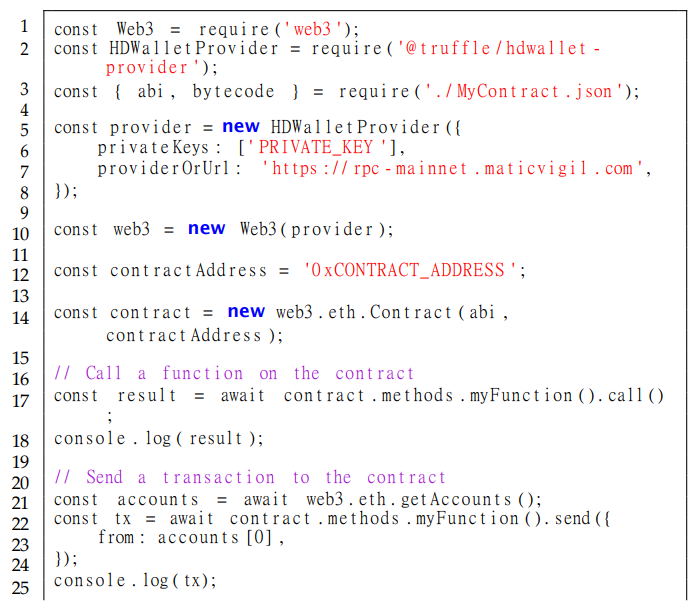and the distribution of digital products.
DM Television
Why Kids Should Learn Blockchain Tech (And How to Make It Easy!)
2 Related Work
2.1 The Impact of Blockchain Technology on Education
2.2 Incorporating Scratch into Tinker Learning for Computational Thinking
2.3 Using Polygon SDK for JavaScript to Interact with a Smart Contract
2.4 Challenges in Blockchain Education and the Need for User-friendly Tools
2.2 Incorporating Scratch into Tinker Learning for Computational ThinkingThe Tinker Learning approach emphasizes hands-on, problem-solving exercises and the use of visual programming languages to engage students in active learning. Scratch, a visual programming language developed by the MIT Media Lab, has been widely used to teach computational thinking and programming to young learners [8]. Research has shown that visual programming tools like Scratch can enhance students’ understanding and engagement with computational thinking concepts, especially for young learners with no prior programming experience [4]. Furthermore, this approach has improved student learning outcomes compared to traditional text-based programming languages [1, 12].
\ Developing 21st-century skills, including critical thinking, communication, collaboration, and creativity, is becoming increasingly important in today’s rapidly evolving job market. According to a report by the World Economic Forum, these skills are considered essential for success in the Fourth Industrial Revolution [9]. Therefore, incorporating Scratch into the Tinker Learning approach, which focuses on developing these skills, is well-aligned with the needs of the modern workforce.
2.3 Using Polygon SDK for JavaScript to Interact with a Smart ContractInteracting with a smart contract on the Polygon blockchain using JavaScript typically involves importing the necessary libraries, defining the contract’s ABI and bytecode, creating a new instance of HDWalletProvider, and then making a new instance of Web3, passing in the provider. The contract’s address is then defined, and a new contract instance is created using the ABI and address. The Polygon SDK for JavaScript provides many tools and functions for working with smart contracts on the Polygon network. An example code snippet showing how to use Polygon SDK for JavaScript to interact with a smart contract on the Polygon blockchain is as follows:
\
\

\ \ In this example, we first import the necessary libraries, including Web3 and HDWalletProvider. We then define the contract’s ABI and bytecode. We create a new instance of HDWalletProvider, passing in our private key and the Polygon Mainnet RPC endpoint URL. We then make a new model of Web3, passing in the provider. We define the contract’s address and create a new contract instance using the ABI and address. We can then call functions on the
\
\

\ \ or send transactions to the contract using the
\
\

\ \ passing in the from address. This is just a basic example, and the specific details of interacting with a smart contract on the Polygon blockchain will depend on the contract itself. However, teaching K-12 students how to interact with smart contracts using JavaScript can be challenging due to the technical complexity of the process. Students may struggle with understanding the concepts of wallets, private keys, and blockchain network endpoints, which are required for interacting with a smart contract. Additionally, there is a lack of user-friendly tools and methods that enable young learners to explore blockchain technology fun and intuitively.
2.4 Challenges in Blockchain Education and the Need for User-friendly ToolsWhile blockchain technology, particularly NFTs, can potentially transform various industries, including education [6], the technical complexity and lack of accessible tools have been identified as significant barriers to its adoption in K-12 education [14]. Research has suggested that user-friendly tools and approaches are crucial to making blockchain education more accessible and engaging for young learners [16].
\ Non-fungible tokens (NFTs) are a type of digital asset that can represent unique items, such as artwork or collectibles. They are built on blockchain technology and have been used in various industries, including education [6]. NFTs can provide new opportunities for students to learn about digital ownership and value. However, the technical complexity of blockchain technology has been identified as a significant barrier to its adoption in K-12 education [14]. User-friendly tools and approaches, such as visual programming languages and gamification, can make blockchain education more accessible and engaging for young learners [6, 16].
\ Therefore, there is a need to develop innovative and user-friendly tools and methods to enable students to explore new technologies and concepts like blockchain. By leveraging the power of visual programming languages and innovative teaching methods like Tinker Learning, we hope to inspire a new generation of blockchain enthusiasts and foster a deeper understanding of digital ownership and value.
\ To address these challenges, developing educational resources and tools that simplify interacting with smart contracts using JavaScript is essential. This can involve leveraging visual programming languages and gamification to make the process more engaging and accessible to young learners. Additionally, the development of innovative teaching methods like Tinker Learning can help students develop 21st-century skills, including critical thinking, communication, collaboration, and creativity, which are essential for success in the modern workforce. Adopting such approaches can inspire a new generation of blockchain enthusiasts and foster a deeper understanding of digital ownership and value.
\
:::info Authors:
(1) Yun-Cheng Tsai, National Taiwan Normal University, Taipei, Taiwan (pecu@ntnu.edu.tw);
(2) Jiun-Yu Huang, Small Town Intelligence Co., Ltd, Taiwan (yillkid@gmail.com);
(3) Da-Ru Chiou, Taitung Tung Hai Junior High School, Taiwan (1234567si2k@gmail.com).
:::
:::info This paper is available on arxiv under CC BY 4.0 DEED license.
:::
\
- Home
- About Us
- Write For Us / Submit Content
- Advertising And Affiliates
- Feeds And Syndication
- Contact Us
- Login
- Privacy
All Rights Reserved. Copyright 2025, Central Coast Communications, Inc.